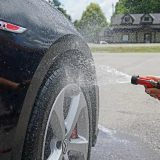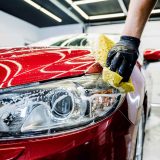Car maintenance is an essential part of owning a vehicle. Regular maintenance not only ensures that your car runs smoothly and efficiently, but it also helps to protect and preserve its appearance. One crucial aspect of car maintenance is car waxing. Car waxing plays a crucial role in protecting the paint of your vehicle from various elements such as UV rays, dirt, and debris. In this article, we will explore the importance of car waxing, the different types of car wax available, how to prepare your car for waxing, step-by-step guide to applying car wax, choosing the right applicator, how often you should wax your car, common mistakes to avoid when waxing your car, top car wax brands, the benefits of ceramic coating, and tips for maintaining your car's showroom shine.
Key Takeaways
- Regular car waxing is important to protect your vehicle's paint from damage caused by UV rays, dirt, and other environmental factors.
- There are different types of car wax available, including natural, synthetic, and hybrid options, each with their own benefits and drawbacks.
- Before waxing your car, it's important to properly wash and dry it, and remove any contaminants or debris from the surface.
- Applying car wax involves spreading a thin layer of wax onto the surface of the car, allowing it to dry, and then buffing it off with a clean cloth or buffer.
- Choosing the right applicator for your car wax can depend on the type of wax you're using and the size and shape of your vehicle. Common options include foam pads, microfiber cloths, and applicator mitts.
- Experts recommend waxing your car every 3-6 months, depending on factors like climate, usage, and storage conditions.
- Common mistakes to avoid when waxing your car include using too much wax, applying it in direct sunlight, and using abrasive or dirty cloths.
- Top car wax brands include Meguiar's, Turtle Wax, and Chemical Guys, among others.
- Ceramic coating is a more expensive but longer-lasting alternative to traditional car wax, offering superior protection and shine.
- To maintain your car's showroom shine, it's important to regularly wash and wax it, avoid parking in direct sunlight, and address any scratches or damage promptly.
The Importance of Car Waxing: Why You Should Do It Regularly
Car waxing is not just about making your car look shiny and new; it serves a much more important purpose. One of the main benefits of car waxing is that it acts as a protective barrier between your car's paint and the elements. The wax creates a layer that shields the paint from harmful UV rays, dirt, and debris. This protection helps to prevent fading, oxidation, and damage to the paint job.
Regular waxing can also extend the life of your car's paint job. Over time, exposure to the sun's UV rays can cause the paint to fade and lose its luster. Waxing regularly helps to maintain the integrity of the paint by providing an extra layer of protection. It also helps to prevent small scratches and swirl marks from forming on the surface of the paint.
Types of Car Wax: Which One is Right for Your Vehicle?
There are several types of car wax available on the market, each with its own set of pros and cons. The three main types of car wax are natural wax, synthetic wax, and spray wax.
Natural wax, also known as carnauba wax, is derived from the leaves of the carnauba palm tree. It is known for its deep shine and excellent water-repellent properties. Natural wax provides a warm, glossy finish and is often preferred by car enthusiasts for its high-quality results. However, natural wax tends to be more expensive than synthetic wax and may require more frequent applications.
Synthetic wax, on the other hand, is made from polymers and other synthetic materials. It is known for its durability and long-lasting protection. Synthetic wax is often easier to apply and remove than natural wax, making it a popular choice for those who want a quick and easy waxing process. However, synthetic wax may not provide the same level of shine as natural wax.
Spray wax is a convenient option for those who want a quick touch-up between regular waxing sessions. It comes in a spray bottle and can be applied directly to the surface of the car. Spray wax is easy to use and provides a glossy finish. However, it may not offer the same level of protection as natural or synthetic wax.
When choosing the right type of car wax for your vehicle, consider factors such as your budget, desired level of shine, and ease of application. It's also important to read reviews and consider recommendations from experts or fellow car enthusiasts.
Preparing Your Car for Waxing: Tips for a Flawless Finish
| Step | Description |
|---|---|
| 1 | Wash your car thoroughly with soap and water to remove any dirt or debris. |
| 2 | Dry your car completely with a microfiber towel to prevent water spots. |
| 3 | Clay bar your car to remove any contaminants that washing couldn't remove. |
| 4 | Inspect your car for any scratches or swirl marks that need to be addressed. |
| 5 | Apply a pre-wax cleaner to remove any remaining contaminants and to enhance the shine. |
| 6 | Apply the wax using a foam applicator pad in a circular motion. |
| 7 | Let the wax dry to a haze and then buff it off with a microfiber towel. |
| 8 | Repeat the waxing process on any areas that need additional protection. |
| 9 | Enjoy your flawlessly waxed car! |
Before applying car wax, it's essential to properly prepare your car's surface to ensure a flawless finish. The first step is to wash your car thoroughly using a mild car wash soap and a microfiber wash mitt or sponge. This will remove any dirt, dust, or debris that may be on the surface of the paint.
After washing, it's important to dry your car thoroughly using a microfiber drying towel or a leaf blower. This will prevent water spots from forming on the paint. It's also a good idea to park your car in a shaded area to avoid direct sunlight, as this can cause the water to evaporate quickly and leave behind water spots.
Once your car is dry, it's time to remove any contaminants that may be stuck to the paint. This can be done using a clay bar or a clay mitt. Simply spray a lubricant onto the surface of the paint and gently rub the clay bar or mitt back and forth. This will help to remove any embedded contaminants such as tree sap, tar, or bug residue.
After using the clay bar, it's important to wash your car again to remove any residue left behind. Once your car is clean and dry, it's ready for waxing.
Step-by-Step Guide to Applying Car Wax: From Washing to Buffing
Applying car wax may seem like a daunting task, but with the right tools and techniques, it can be a straightforward process. Here is a step-by-step guide to help you achieve a flawless finish:
1. Start by washing your car thoroughly using a mild car wash soap and a microfiber wash mitt or sponge. Rinse off any soap residue and dry your car using a microfiber drying towel or a leaf blower.
2. Once your car is dry, inspect the surface for any imperfections such as scratches or swirl marks. If necessary, use a scratch remover or polish to correct these imperfections before waxing.
3. Choose the type of wax that is suitable for your car and gather all the necessary tools and materials. This may include an applicator pad or sponge, microfiber towels for buffing, and of course, the wax itself.
4. Apply a small amount of wax onto the applicator pad or sponge. Start by working on one section of the car at a time, such as the hood or roof. Apply the wax in a thin, even layer using circular or back-and-forth motions.
5. Allow the wax to dry to a haze, which usually takes a few minutes. The drying time may vary depending on the type of wax you are using, so be sure to read the instructions on the product label.
6. Once the wax has dried to a haze, it's time to buff it off. Use a clean microfiber towel and apply light pressure as you buff the wax in circular motions. This will help to remove any excess wax and bring out the shine.
7. Continue this process until you have waxed the entire car. Be sure to pay attention to hard-to-reach areas such as door handles, side mirrors, and trim.
8. After buffing, take a step back and admire your work. Your car should now have a beautiful, glossy shine that is protected from the elements.
Choosing the Right Applicator: Which One is Best for Your Car Wax?

Choosing the right applicator is crucial for achieving a smooth and even application of car wax. There are several types of applicators available, each with its own set of pros and cons.
Microfiber towels are one of the most popular choices for applying car wax. They are soft, absorbent, and lint-free, making them ideal for spreading wax evenly across the surface of the paint. Microfiber towels also help to minimize the risk of scratching or marring the paint.
Foam pads are another popular choice for applying car wax. They come in various shapes and sizes and can be attached to a machine polisher or used by hand. Foam pads provide a smooth and even application of wax and help to reduce product waste.
Applicator sponges are another option for applying car wax. They are typically made from foam or microfiber material and come in various shapes and sizes. Applicator sponges are easy to use and provide good control over the application of wax.
When choosing the right applicator for your car wax, consider factors such as the type of wax you are using, the size and shape of the applicator, and your personal preference. It's also important to keep your applicators clean and free from any contaminants that may affect the quality of the wax application.
How Often Should You Wax Your Car? Experts Weigh In
The frequency at which you should wax your car depends on several factors, including climate, usage, and personal preference. Generally, it is recommended to wax your car every three to six months. However, this can vary depending on the conditions your car is exposed to.
If you live in an area with harsh weather conditions, such as extreme heat or cold, it may be necessary to wax your car more frequently. The same applies if you frequently drive on dusty or gravel roads, as these conditions can cause more wear and tear on your car's paint.
Experts also recommend waxing your car after washing it. This helps to maintain the protective barrier provided by the wax and ensures that your car's paint is always protected.
Ultimately, the best way to determine how often you should wax your car is to pay attention to its appearance. If you notice that the paint is starting to look dull or faded, it may be time for a fresh coat of wax.
Common Mistakes to Avoid When Waxing Your Car
While waxing your car is a relatively simple process, there are some common mistakes that people make that can affect the quality of the finish. Here are some mistakes to avoid when waxing your car:
1. Using too much wax: Applying too much wax can lead to streaks and an uneven finish. It's important to use a small amount of wax and spread it evenly across the surface of the paint.
2. Not buffing properly: Buffing is an essential step in the waxing process. It helps to remove any excess wax and bring out the shine. Be sure to use a clean microfiber towel and apply light pressure as you buff the wax in circular motions.
3. Applying wax in direct sunlight: Waxing your car in direct sunlight can cause the wax to dry too quickly, making it difficult to buff off. It's best to wax your car in a shaded area or during cooler parts of the day.
4. Neglecting to wash and dry your car before waxing: It's important to wash and dry your car thoroughly before applying wax. This helps to remove any dirt, dust, or debris that may be on the surface of the paint and ensures a smooth application of wax.
5. Using the wrong type of wax for your car: Not all waxes are created equal, and using the wrong type of wax for your car can affect the quality of the finish. Be sure to choose a wax that is suitable for your car's paint and follow the instructions on the product label.
To avoid these mistakes, it's important to read the instructions on the product label and follow them carefully. It's also a good idea to practice on a small, inconspicuous area of your car before applying wax to the entire surface.
Top Car Wax Brands: Which Ones Deliver the Best Results?
There are several top car wax brands in the market that deliver excellent results. Here are some of the top brands to consider:
1. Meguiar's: Meguiar's is a well-known brand in the car care industry and offers a wide range of car waxes for different needs. Their products are known for their high-quality results and long-lasting protection.
2. Turtle Wax: Turtle Wax is another popular brand that offers a variety of car waxes at affordable prices. Their products are easy to use and provide a deep, glossy shine.
3. Chemical Guys: Chemical Guys is a brand that is known for its high-quality car care products. They offer a wide range of car waxes, including natural waxes, synthetic waxes, and spray waxes.
4. Collinite: Collinite is a brand that specializes in producing high-quality car waxes and polishes. Their products are known for their durability and long-lasting protection.
5. Griot's Garage: Griot's Garage is a brand that is highly regarded by car enthusiasts for its high-quality car care products. Their waxes are known for their ease of use and excellent results.
When choosing a car wax brand, it's important to consider factors such as your budget, desired level of shine, and ease of application. It's also a good idea to read reviews and consider recommendations from experts or fellow car enthusiasts.
The Benefits of Ceramic Coating: Is It Worth the Investment?
Ceramic coating is a relatively new technology in the world of car care. It is a liquid polymer that is applied to the surface of the paint and forms a protective layer that bonds with the paint at a molecular level. Ceramic coating offers several benefits, including long-lasting protection, easy maintenance, and enhanced gloss.
One of the main benefits of ceramic coating is its long-lasting protection. Unlike traditional wax, which needs to be reapplied every few months, ceramic coating can last for several years with proper care. It provides a durable barrier against UV rays, dirt, and debris, helping to prevent fading, oxidation, and damage to the paint.
Ceramic coating also makes it easier to maintain your car's appearance. The hydrophobic properties of ceramic coating repel water and other liquids, making it easier to clean your car. It also helps to prevent dirt and grime from sticking to the surface of the paint, reducing the need for frequent washing.
Another benefit of ceramic coating is its ability to enhance the gloss and shine of your car's paint. The coating creates a smooth, reflective surface that gives your car a showroom-like finish. It also helps to bring out the depth and clarity of the paint, making it look more vibrant and lustrous.
While ceramic coating offers several benefits, it is important to note that it is a more expensive option compared to traditional wax. The cost of ceramic coating can vary depending on factors such as the size of your car and the brand of the coating. However, many car owners find that the long-lasting protection and easy maintenance provided by ceramic coating are worth the investment.
Maintaining Your Showroom Shine: Tips for Keeping Your Car Looking Its Best
After waxing or applying ceramic coating to your car, it's important to maintain its showroom shine to keep it looking its best. Here are some tips for maintaining your car's appearance:
1. Wash your car regularly: Regular washing is essential for removing dirt, dust, and other contaminants that can dull the appearance of your car's paint. Use a mild car wash soap and a microfiber wash mitt or sponge to avoid scratching the paint.
2. Avoid harsh chemicals: Harsh chemicals such as bleach or ammonia-based cleaners can damage the paint of your car. It's best to use products that are specifically designed for automotive use.
3. Dry your car thoroughly: After washing, be sure to dry your car thoroughly using a microfiber drying towel or a leaf blower. This will help to prevent water spots from forming on the surface of your car. Water spots can be unsightly and difficult to remove, so it's important to take the time to dry your car properly. Using a microfiber drying towel is a gentle and effective way to remove any remaining water droplets. Alternatively, a leaf blower can be used to quickly and efficiently dry your car, especially in hard-to-reach areas. Whichever method you choose, make sure to dry both the exterior and interior of your car to ensure a spotless finish.
Looking to keep your car looking shiny and protected? Check out this article on car waxing tips for a Red Hyundai Veloster. Whether you own a black Ford F-150, a white Hyundai sedan, or even an orange Ford Explorer, proper car waxing is essential for maintaining the paint's luster and protecting it from the elements. Don't forget to visit our website for more car detailing articles and expert advice.





